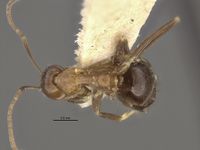Nylanderia opisopthalmia
| Nylanderia opisopthalmia | |
|---|---|

| |
| Scientific classification | |
| Kingdom: | Animalia |
| Phylum: | Arthropoda |
| Class: | Insecta |
| Order: | Hymenoptera |
| Family: | Formicidae |
| Subfamily: | Formicinae |
| Tribe: | Lasiini |
| Genus: | Nylanderia |
| Species: | N. opisopthalmia |
| Binomial name | |
| Nylanderia opisopthalmia (Zhou & Zheng, 1998) | |
| Synonyms | |
| |
Identification
Williams and LaPolla (2016) - While this species is currently placed in Nylanderia, the morphology appears to be most consistent to that of Zatania species: (1) abundant pubescence on the head; (2) scapes with no erect setae; (3) compound eyes placed far posterior to the midline of the head (EPI > 167); and (4) shallow and incomplete mesonotal and metanotal sutures. Nylanderia opisopthalmia differs from both genera in that it has 7–8 teeth on the masticatory margin, while Nylanderia species almost exclusively have 6 and Zatania species have 5–6. Although the placement of this species in Zatania is weakly supported by our parsimony analysis (BS = 12), no Zatania species are known outside of Central America and the Greater Antilles. Since our focus was specifically on the revision of Prenolepis and the Asian Nylanderia are in need of taxonomic treatment, we adopt a conservative approach and leave this species in Nylanderia pending further investigation.
Distribution
Latitudinal Distribution Pattern
Latitudinal Range: 30.7925° to 25.169444°.
| North Temperate |
North Subtropical |
Tropical | South Subtropical |
South Temperate |
- Source: AntMaps
Distribution based on Regional Taxon Lists
Oriental Region: Vietnam.
Palaearctic Region: China (type locality).
Distribution based on AntMaps
Distribution based on AntWeb specimens
Check data from AntWeb
Countries Occupied
| Number of countries occupied by this species based on AntWiki Regional Taxon Lists. In general, fewer countries occupied indicates a narrower range, while more countries indicates a more widespread species. |

|
Estimated Abundance
| Relative abundance based on number of AntMaps records per species (this species within the purple bar). Fewer records (to the left) indicates a less abundant/encountered species while more records (to the right) indicates more abundant/encountered species. |

|
Biology
Castes
Nomenclature
The following information is derived from Barry Bolton's Online Catalogue of the Ants of the World.
- opisopthalmia. Paratrechina opisopthalmia Zhou & Zheng, 1998a: 44, figs. 5, 6 (w.) CHINA.
- Combination in Nylanderia: LaPolla, Brady & Shattuck, 2010a: 127.
- Status as species: Zhou, 2001b: 182.
- Senior synonym of septemdenta: Williams & LaPolla, 2016: 248.
- septemdenta. Prenolepis septemdenta Wang, W. & Wu, 2007: 722, figs. 3, 4 (w.) CHINA.
- Junior synonym of opisopthalmia: Williams & LaPolla, 2016: 248.
Unless otherwise noted the text for the remainder of this section is reported from the publication that includes the original description.
Description
Worker
Williams and LaPolla (2016) - (n=3): CMC: 6–16; EL: 0.26–0.28; EW: 0.22; HL: 0.89–0.92; HLA: 0.47; HLP: 0.24–0.28; HW: 0.73–0.75; IOD: 0.47–0.48; LF1: 0.21–0.24; LF2: 0.09–0.13; LHT: 0.95–1.11; MMC: 1; MTW: 0.48–0.49; MW: 0.32; PDH: 0.37–0.39; PMC: 0–3; PrCL: 0.51–0.57; PrCW: 0.31–0.36; PrFL: 0.86–1.07; PrFW: 0.23–0.24; PTH: 0.39–0.40; PTL: 0.34–0.39; PTW: 0.27–0.29; PW: 0.55–0.58; SL: 1.03–1.17; TL: 3.21–3.74; WF1: 0.08–0.09; WF2: 0.07; WL: 1.20–1.35; BLI: 161–186; CI: 79–83; EPI: 167–193; FLI: 189–248; HTI: 131–150; PetHI: 104–106; PetWI: 76–81; PrCI: 61–63; PrFI: 22–27; REL: 29–32; REL2: 36–38; REL3: 56–59; SI: 138–162.
Medium to dark brown; entire cuticle reticulate to finely reticulate; short, black, and erect macrosetae with thick setal bases on head, pronotum, mesonotum, and gaster; no setae on scapes, metanotum, or propodeum; fine, dense pubescence covering most of the cuticle, including the scapes; head longer than broad and rectangular in shape with indistinct posterolateral corners and a short, straight posterior margin; compound eyes are large and convex, but not surpassing the lateral margins of the head in full-face view; mandibles with 7–8 teeth on the masticatory margin; ectal surface of the mandibles with deep longitudinal striations; in profile view, the dorsal surface of the mesonotum is flattened and elongate; propodeum is highly domed with a rounded dorsal face; dorsal apex of petiole scale is sharply angled and forward-inclined.
Type Material
Williams and LaPolla (2016) - Holotype worker, China: Guangxi Province, Huaping Nature Reserve, 25°10.10’N 109°48.54’E, 534m (Guangxi Normal University) [examined].
References
- Williams, J. L. and J. S. LaPolla. 2016. Taxonomic revision and phylogeny of the ant genus Prenolepis (Hymenoptera: Formicidae). 4200(2):201–258. doi:10.11646/zootaxa.4200.2.1
- Zhou, S.; Zheng, Z. 1998a. Three new species and a new record species of tribe Prenolepidini (Hymenoptera: Formicidae) from Guangxi, China. Entomol. Sin. 5: 42-46 (page 44, figs. 5, 6 worker described)
References based on Global Ant Biodiversity Informatics
- Cheng D., Z. Chen, and S. Zhou. 2015. An analysis on the ant fauna of Jinzhongshan Nature Reserve in Gunagxi, China. Journal of Guangxi Normal University: Natural Science Edition 33(3): 129.137.
- Guénard B., and R. R. Dunn. 2012. A checklist of the ants of China. Zootaxa 3558: 1-77.
- Lu C. 2013. The ant fauna in DamingShan National Nature Reserve of Guangxi. Master's Thesis Guangxi Normal University, 83 pages.
- Ran H., and S. Y. Zhou. 2012. Checklist of chinese ants: formicomorph subfamilies (Hymenoptera: Formicidae) II. Journal of Guangxi Normal University: Natural Science Edition 30(4): 81-91.
- Williams J. L., and J. S. LaPolla. 2016. Taxonomic revision and phylogeny of the ant genus Prenolepis (Hymenoptera: Formicidae). Zootaxa 4200: 201-258.
- Zhou S.-Y. and Zheng Z. 1998. Three new species and a new record species of tribe Prenolepidini (Hymenoptera: Formicidae) from Guangxi, China. Entomologia Sinica 5(1): 42-46

